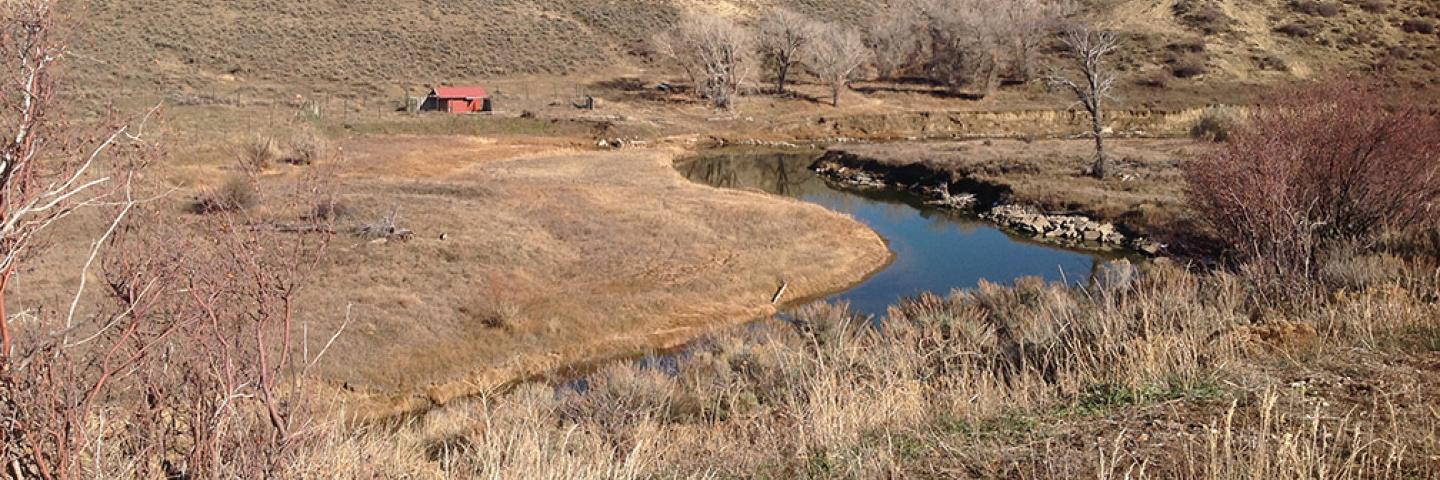Streambank Stabilization Project Withstands High Spring Flows

Streambank Stabilization Project Withstands High Spring Flows
In 2018, producers Laine & Tim O’Neal of Elkhead Creek Ranch began working with the Natural Resources Conservation Service (NRCS) to address stream and riparian degradation on the Elkhead Creek. The O’Neals own and run a rotational Wagyu beef operation aptly named after the creek which flows through their property. The creek is a tributary to the Yampa River which flows through Routt and Moffat counties in northwest Colorado and belongs to the Colorado River Watershed.
Concerns on the lower Elkhead Creek have been mounting for years due to the upstream Elkhead Reservoir and dam. The reservoir improves water storage within the basin which can provide releases in times of low flows for municipalities, agricultural water users, and endangered and threatened fish species downstream. While these benefits are invaluable, water releases can lead to high flows for long durations just below the dam, resulting in wide-ranging impacts to downstream water users, ranchers, and wildlife. These impacts include degradation of riparian and in-stream habitat, excessive bank erosion leading to agricultural land loss and poor water quality, and diversion issues for irrigators.
The O’Neals are part of a group of landowners along the creek that are motivated to begin to find and implement solutions to these problems. During the initial field visit with NRCS staff, about 1.2 miles of stream was walked discussing the critical areas of bank erosion from stream channel incision. These critical areas of bank erosion are of large concern for the O’Neals because they are losing productive land, which was evidenced by multiple fences which have fallen into the creek in recent years. They were also becoming increasingly concerned with the fish habitat along the creek. After this initial walk through, it was time to bring in other partners and engineers to discuss funding and draft a design for the streambank restoration.
Colorado Parks and Wildlife (CPW) was looped into the project to conduct fish surveys to determine what fish habitat improvements could be incorporated into the project. Engineers came out to survey and begin designing the improvements needed to address the concerns and after the design was complete, the O’Neals began to look at the cost of the project and explore partnering opportunities to help contribute financially.
The US Fish and Wildlife Services along with Trout Unlimited (TU) came on board to help support the project. “When TU was approached by the landowner and NRCS, the project seemed like a natural fit for Trout Unlimited's mission in Northwest Colorado,” shares Ian Wilson, TU’s project manager. “By reducing sedimentation caused by unstable banks, we hope to improve the water quality of both Elkhead Creek and the larger Yampa River.”
Due to the large scope of the project, it was decided to divide the implementation into two phases. Phase I addressed about 500 feet of bank and was completed in 2021. Practices installed during this phase include a log vane, rock toe, rock cutoff sills, bank shaping, mulching, seeding, and tree plantings. These practices have demonstrated tremendous success at preventing further erosion. “We were very happy with the way the Phase I project held over the high flows this past season,” says Laine.
In the spring of 2023, Elkhead Creek saw near historic flows moving through the creek after the high snowpack of the 2022-2023 winter season. “Phase I has proven itself during this past high-water year. We are really looking forward to seeing how Phase II plays out, and if we have another high-water year, it should really help lessen the amount of streambank we are losing and the amount of sediment we see floating downstream.”
Phase II of the project is currently in construction and consists of new methods which incorporate sod clumps to reinforce the bank toe. Phase II is much larger in scope covering almost a half-mile of stream. It is also more diverse in the types of methods and structures used such as toe wood, rock deflectors, backwater log habitat, pool improvements, and rootwad structures. The incorporation of more wood is intended to improve fish and macroinvertebrate habitat.
“The project itself is improving upon existing in-stream fish habitat with the addition of structures and excavation of existing pools,” says Ian. While the original goal of Phase II was to utilize more bioengineered materials, sourcing of logs with adequate length and diameter has been the greatest challenge to this phase of the project.
Several adjustments have been needed to accommodate the lack of available logs in the area, such as switching from log deflectors to rock deflectors. Nevertheless, the Phase II project is moving along.
Laine says they are already seeing the benefits of all the improvements, “We have been stocking the stream with fishable trout over the past few years and we have a lot of predators, some show how the ecosystem is improving. We find we are sharing the trout with others who are happy to have their share: otters, bald eagles, osprey, muskrats.” She hopes that other landowners along Elkhead Creek will see the benefits that her family has seen with this project and be interested in doing similar work on their properties to improve the overall health of the creek.
“I believe that our downstream neighbors may be already benefiting in a way, and we are more than happy to have folks visit to see how the improvements are helping not only the erosion on our pasture but also the whole ecosystem and the native wildlife that benefits as well.”

